-
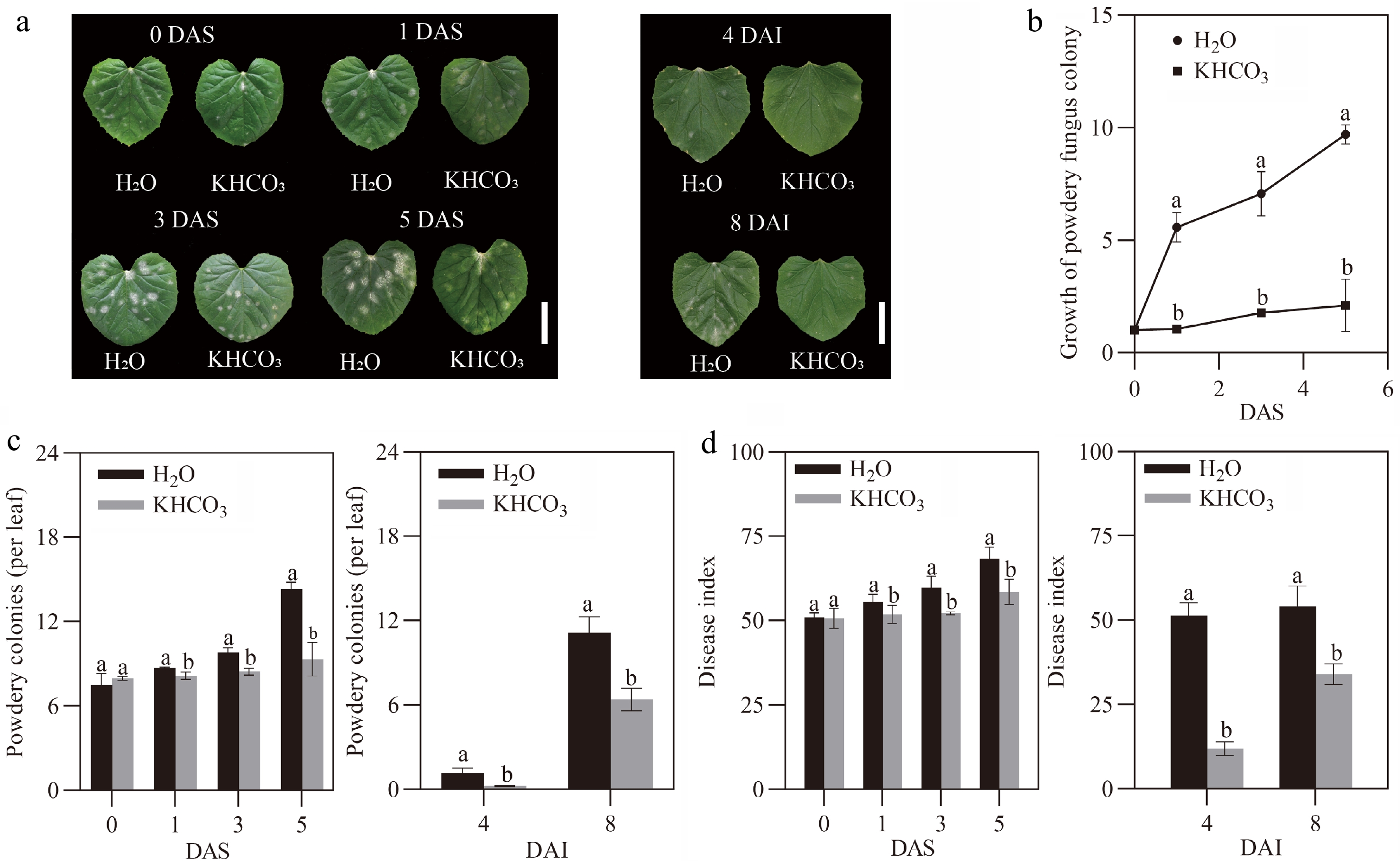
Figure 1.
Effects of KHCO3 spraying on melon seedlings under powdery mildew. (a) Phenotypic comparison between H2O-sprayed (control) and KHCO3-7DAI melon seedlings at 0, 1, 3 and 5 DAS (left panel), and between H2O-sprayed (control) and KHCO3-2DBI melon seedlings at 4 and 8 DAI (right panel). Scale bar = 5 cm. (b) Proliferation evaluation of P. xanthii on the leaves of H2O-sprayed (control) and KHCO3-7DAI melon seedlings at 0, 1, 3 and 5 DAS. (c) Number of powdery mildew spots on the leaves of H2O-sprayed (control) and KHCO3-7DAI melon seedlings at 5 DAS (left panel), and of H2O-sprayed (control) and KHCO3-7DAI seedlings at 8 DAI (right panel). (d) Disease index of H2O-sprayed (control) and KHCO3-7DAI melon seedlings at 0, 1, 3 and 5 DAS (left panel), and of H2O-sprayed (control) and KHCO3-7DAI seedlings at 4 and 8 DAI (right panel). DAS: days after spraying; DAI: days after inoculation. In (b)−(d), the data of each parameter are displayed as mean of three biological repeats ± standard errors (SE), and the different letters indicate significant differences in the comparisons between H2O-sprayed and KHCO3-7DAI/-2DBI samples at a 0.05 statistical level.
-

Figure 2.
Effects of KHCO3 spraying on the activities of phenylpropanoid metabolic enzymes in melon seedlings under powdery mildew. (a) PAL activity in the leaves of H2O-sprayed (control) and KHCO3-7DAI melon seedlings at 0, 1, 3 and 5 DAS (left panel), and of H2O-sprayed (control) and KHCO3-2DBI seedlings at 4 and 8 DAI (right panel). (b) PPO activity in the leaves of H2O-sprayed (control) and KHCO3-7DAI melon seedlings at 0, 1, 3 and 5 DAS (left panel), and of H2O-sprayed (control) and KHCO3-2DBI seedlings at 4 and 8 DAI (right panel). DAI: days after inoculation; DAS: days after spraying. The data of each parameter are displayed as mean of three biological repeats ± standard errors (SE), and the different letters indicate significant difference in the comparison between H2O-sprayed and KHCO3-7DAI/-2DBI samples at a 0.05 statistical level.
-
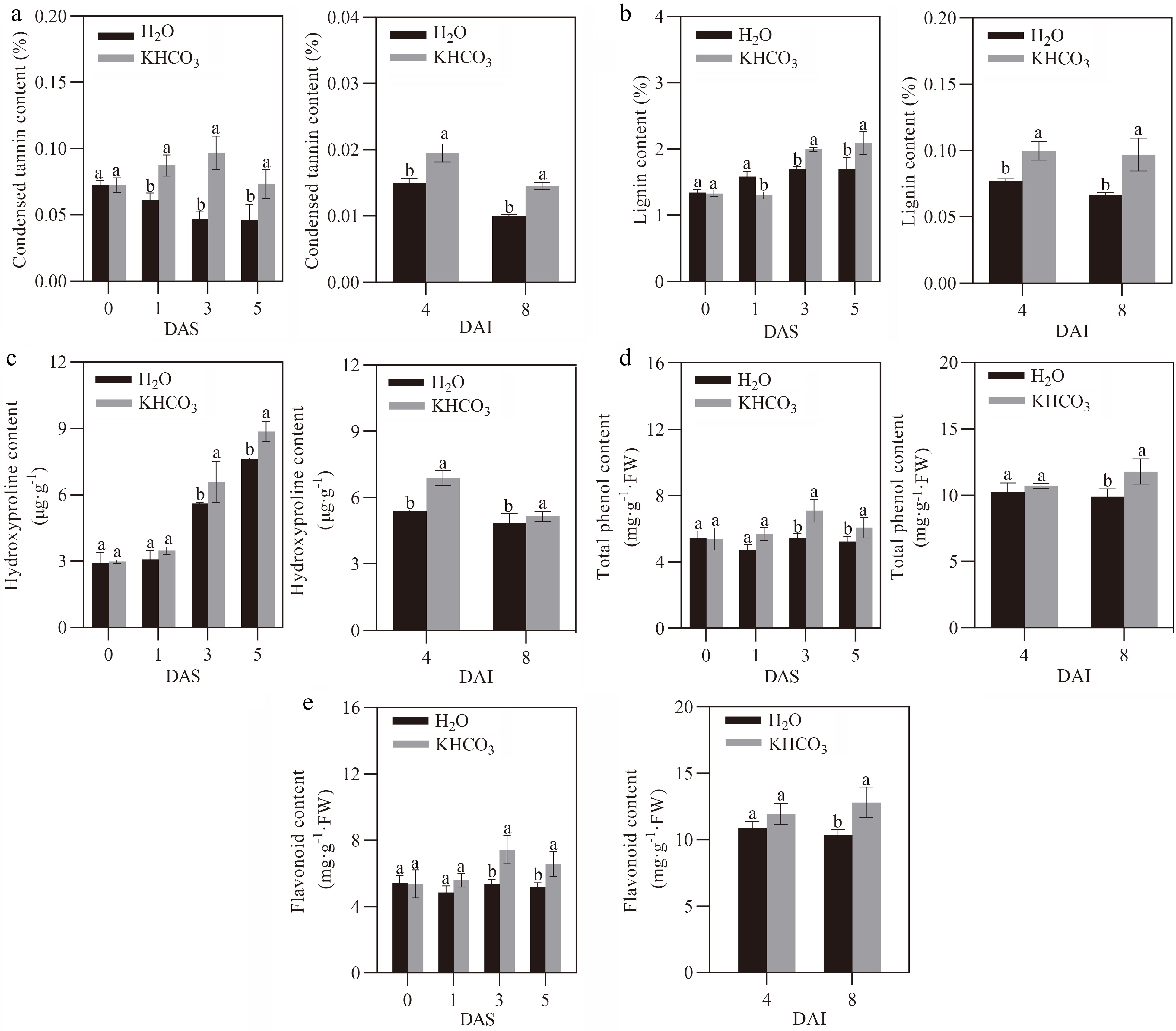
Figure 3.
Effects of KHCO3 spraying on phenylpropanoid metabolite content in melon seedlings under powdery mildew. (a) Condensed tannin content in the leaves of H2O-sprayed (control) and KHCO3-7DAI melon seedlings at 0, 1, 3 and 5 DAS (left panel), and of H2O-sprayed (control) and KHCO3-2DBI seedlings at 4 and 8 DAI (right panel). (b) Lignin content in the leaves of H2O-sprayed (control) and KHCO3-7DAI melon seedlings at 0, 1, 3 and 5 DAS (left panel), and of H2O-sprayed (control) and KHCO3-2DBI seedlings at 4 and 8 DAI (right panel). (c) Hydroxyproline-rich glycoprotein (HRGP) content in the leaves of H2O-sprayed (control) and KHCO3-7DAI melon seedlings at 0, 1, 3 and 5 DAS (left panel), and of H2O-sprayed (control) and KHCO3-2DBI seedlings at 4 and 8 DAI (right panel). (d) Total phenol content in the leaves of H2O-sprayed (control) and KHCO3-7DAI melon seedlings at 0, 1, 3 and 5 DAS (left panel), and of H2O-sprayed (control) and KHCO3-2DBI seedlings at 4 and 8 DAI (right panel). (e) Flavonoid content in the leaves of H2O-sprayed (control) and KHCO3-7DAI melon seedlings at 0, 1, 3 and 5 DAS (left panel), and of H2O-sprayed (control) and KHCO3-2DBI seedlings at 4 and 8 DAI (right panel). DAS: days after spraying; DAI: days after inoculation. The data of each parameter are displayed as mean of three biological repeats ± standard errors (SE), and the different letters indicate significant difference in the comparison between H2O-sprayed and KHCO3-7DAI/-2DBI samples at a 0.05 statistical level.
-
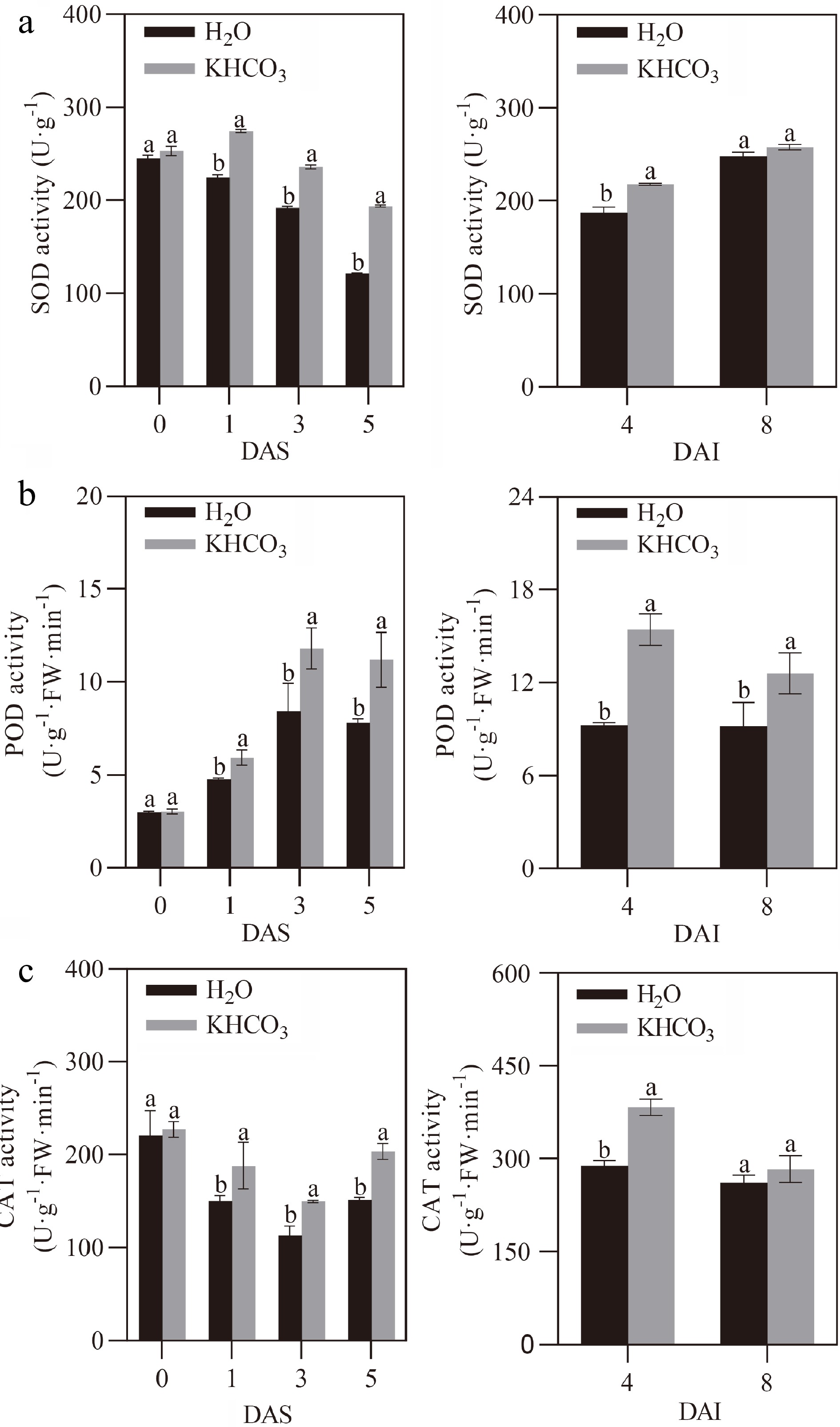
Figure 4.
Effects of KHCO3 spraying on the activities of antioxidant enzymes in melon seedlings under powdery mildew. (a) SOD activity in the leaves of H2O-sprayed (control) and KHCO3-7DAI melon seedlings at 0, 1, 3 and 5 DAS (left panel), and of H2O-sprayed (control) and KHCO3-2DBI seedlings at 4 and 8 DAI (right panel). (b) POD activity in the leaves of H2O-sprayed (control) and KHCO3-7DAI melon seedlings at 0, 1, 3 and 5 DAS (left panel), and of H2O-sprayed (control) and KHCO3-2DBI seedlings at 4 and 8 DAI (right panel). (c) CAT activity in the leaves of H2O-sprayed (control) and KHCO3-7DAI melon seedlings at 0, 1, 3 and 5 DAS (left panel), and of H2O-sprayed (control) and KHCO3-2DBI seedlings at 4 and 8 DAI (right panel). The data of each parameter are displayed as mean of three biological repeats ± standard errors (SE), and the different letters indicate significant difference in the comparison between H2O-sprayed and KHCO3-7DAI/-2DBI samples at a 0.05 statistical level.
-
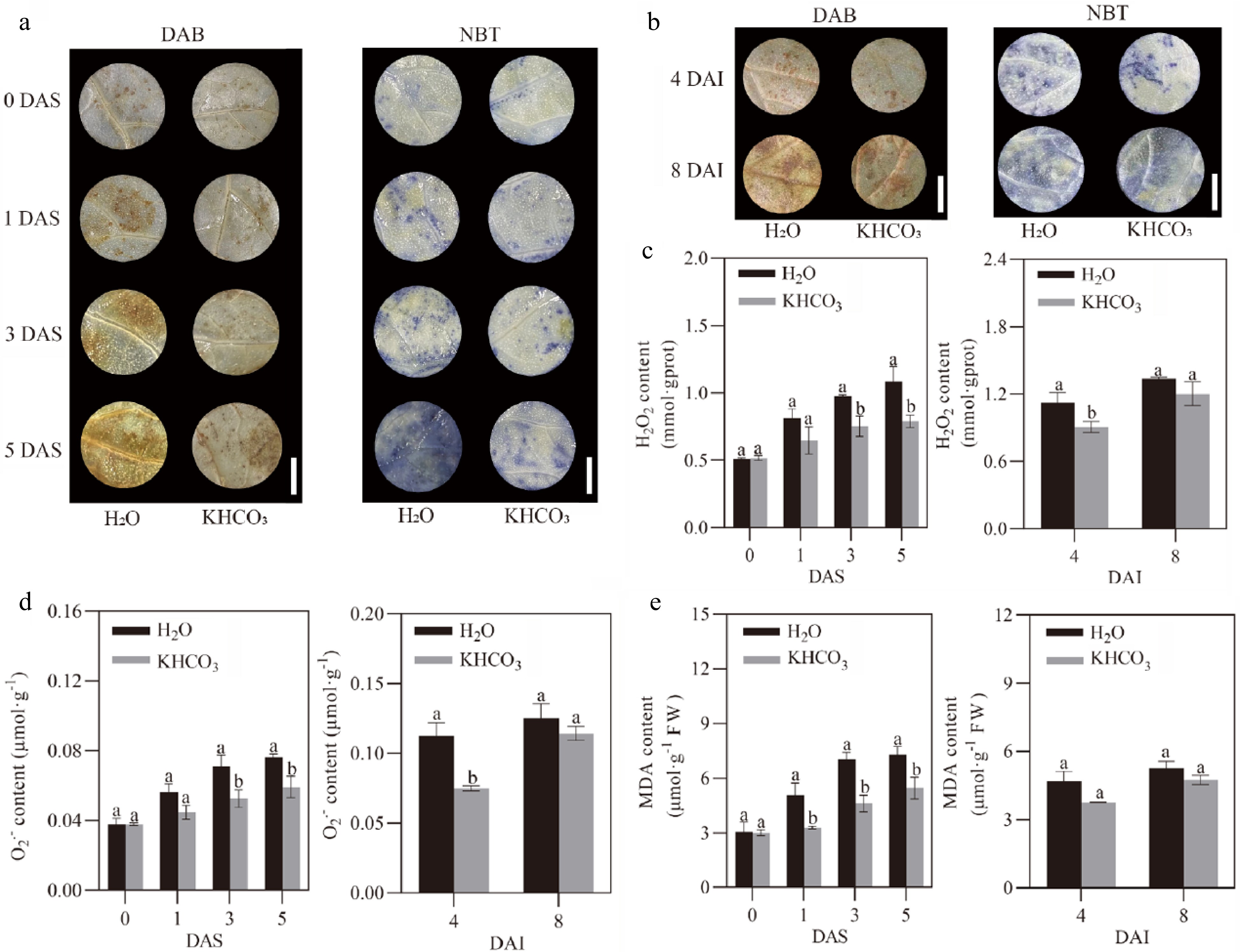
Figure 5.
Effects of KHCO3 spraying on ROS production and lipid peroxidation in melon seedlings under powdery mildew. (a) DAB staining of H2O2 (left panel) and NBT staining of O2.− (right panel) in the leaves of H2O-sprayed (control) and KHCO3-7DAI melon seedlings at 0, 1, 3 and 5 DAS. (b) DAB staining of H2O2 (left panel) and NBT staining of O2.− (right panel) in the leaves of H2O-sprayed (control) and KHCO3-2DBI seedlings at 4 and 8 DAI. (c) H2O2 content in the leaves of H2O-sprayed (control) and KHCO3-7DAI melon seedlings at 0, 1, 3 and 5 DAS (left panel), and of H2O-sprayed (control) and KHCO3-2DBI seedlings at 4 and 8 DAI (right panel). (d) O2.− content in the leaves of H2O-sprayed (control) and KHCO3-7DAI melon seedlings at 0, 1, 3 and 5 DAS (left panel), and of H2O-sprayed (control) and KHCO3-2DBI seedlings at 4 and 8 DAI (right panel). (e) MDA content in the leaves of H2O-sprayed (control) and KHCO3-7DAI melon seedlings at 0, 1, 3 and 5 DAS (left panel), and of H2O-sprayed (control) and KHCO3-2DBI seedlings at 4 and 8 DAI (right panel). DAI: days after inoculation; DAS: days after spraying. In (a) and (b), scale bar = 1 cm. In (c)-(e), the data of each parameter are displayed as mean of three biological repeats ± standard errors (SE), and the different letters indicate significant difference in the comparison between H2O-sprayed and KHCO3-7DAI/-2DBI samples at a 0.05 statistical level.
-
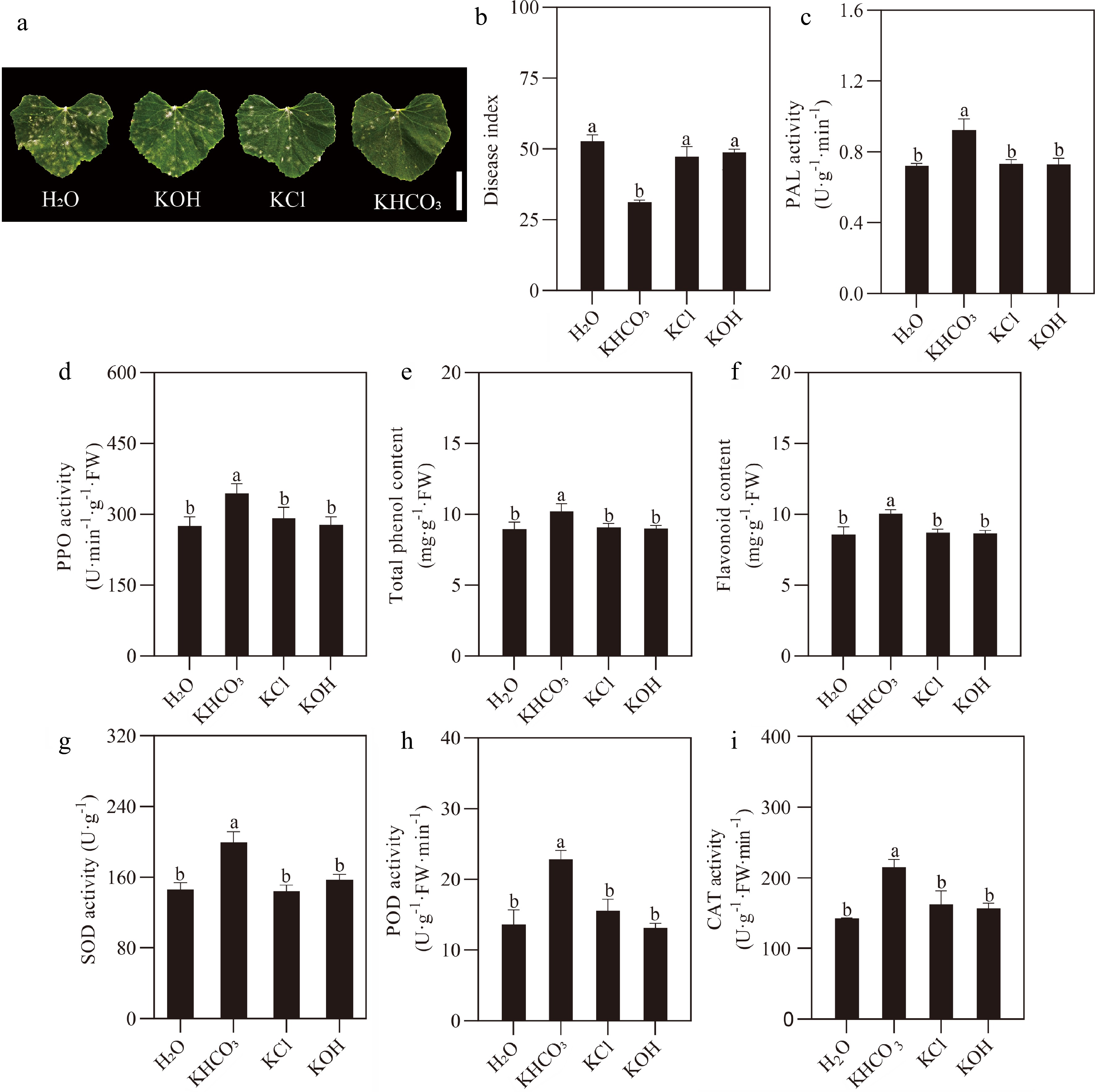
Figure 6.
Responses of melon seedlings to different inorganic salt sprayings under powdery mildew. (a) Phenotypic comparison between H2O- (negative control), KOH-, KCl- sprayed and KHCO3-2DBI melon seedlings (positive control) at the end of 8-day P. xanthii infection course. Scale bar = 5 cm. (b) Number of powdery mildew spots on the leaves of H2O- (negative control), KOH-, KCl-sprayed and KHCO3-2DBI melon seedlings (positive control) at the end of 8-day infection course. (c) PAL and (d) PPO activities in the leaves of H2O- (negative control), KOH-, KCl- sprayed and KHCO3-2DBI melon seedlings (positive control) at the end of 8-day infection course. (e) Total phenol and (f) flavonoid content in the leaves of H2O- (negative control), KOH-, KCl-sprayed and KHCO3-2DBI melon seedlings (positive control) at the end of 8-day infection course. (g) SOD, (h) POD and (i) CAT activities in the leaves of H2O- (negative control), KOH-, KCl- sprayed and KHCO3-2DBI melon seedlings (positive control) at the end of 8-day infection course. The data of each parameter are displayed as mean of three biological repeats ± standard errors (SE), and the different letters indicate significant differences in the comparison between H2O-sprayed and KOH-/KCl-/KHCO3-2DBI samples at a 0.05 statistical level.
-
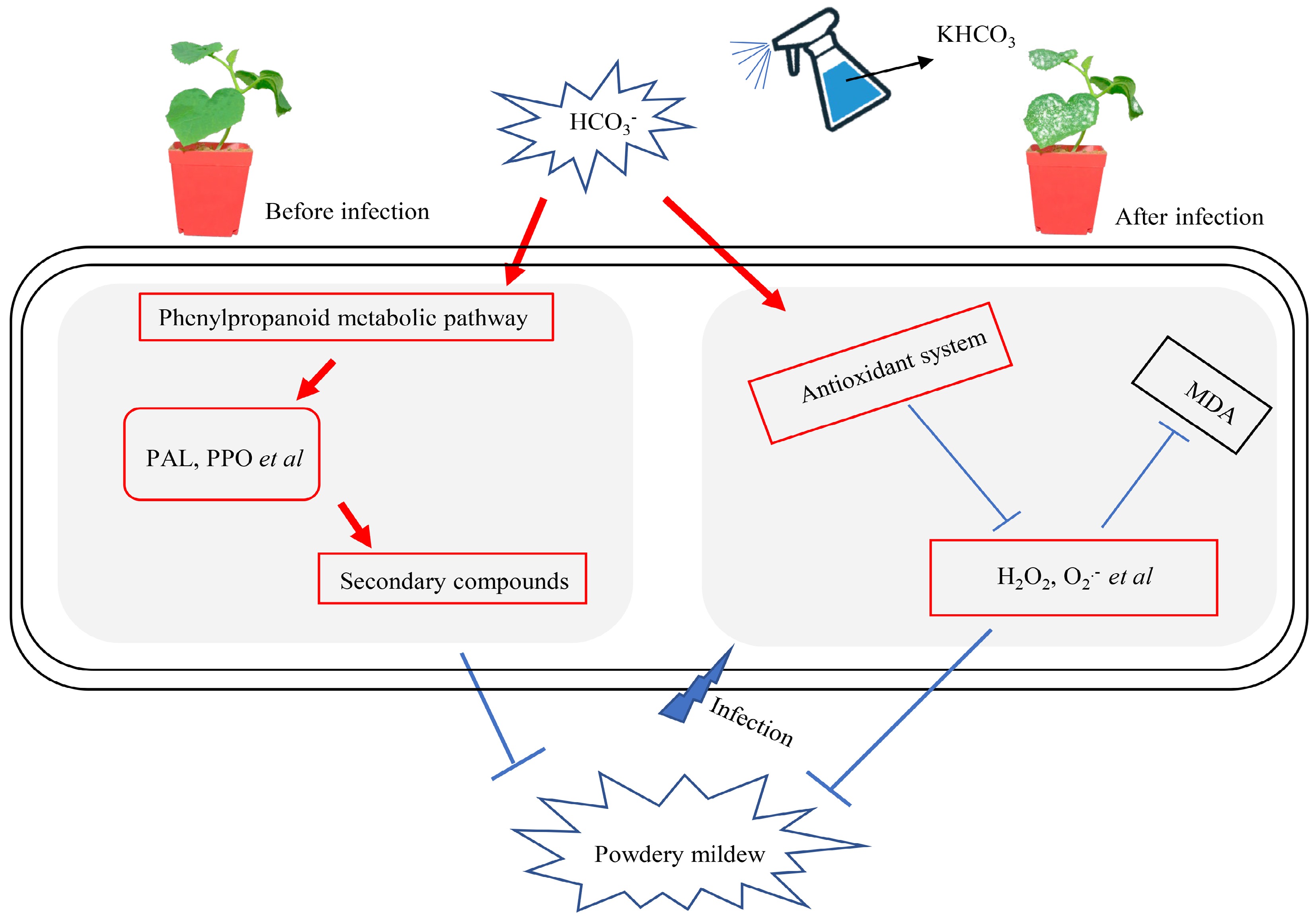
Figure 7.
A proposed model for KHCO3-mediated melon protection from powdery mildew. For melon plants challenged or to be challenged by P. xanthii, HCO3− in the KHCO3 spraying activated phenylpropanoid metabolic pathway to generate more resistance-benefiting metabolites such as HRGP and lignin, conferring inhibitory effects on pathogen development; simultaneously, the activities of key antioxidant enzymes were enhanced to scavenge the overaccumulated ROS, protecting host plants from oxidative damage; and therefore, improved growth performance could be obtained for melon plants under powdery mildew.
-
Gene Forward primer (5′→3′) Reverse primer (5′→3′) PxTUB2 TTGTAGGAATCACATCCCTTTCTC TTCTTCCGGTTGCATGGGTGGTTC CmACT7 GGCTGGATTTGCCGGTGATGATGC GGAAGGAGGAAATCAGTGTGAACC Table 1.
Primers used in qRT-PCR analysis.
Figures
(7)
Tables
(1)